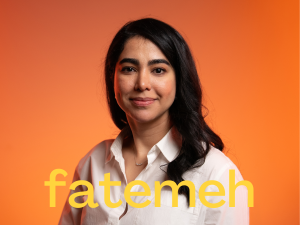‟ I’ve always been curious about how things work. As a child, I had an adorable electric toy that fascinated me. I wanted to know how it worked and where its power came from. That curiosity stayed with me and never faded.”
This is Fatemeh Kavehmadavani’s story. Originally from Shiraz, Iran, Fatemeh’s journey showcases resilience and vision. From earning degrees in signal processing to pursuing a PhD during the 2021 pandemic, she transformed isolation into innovation. Today, she pioneers AI-powered wireless communication technologies shaping 6G’s future. In a world craving seamless connectivity, her research couldn’t be more essential. Here’s what she shared about her work, her inspirations, and why ensuring universal connectivity matters for everyone.
Relive the conversation—transcript below!
What was it like when you joined SnT?
I arrived in Luxembourg in February 2021 to start my PhD, so it was during the COVID pandemic. You can imagine these weren’t ideal conditions to start a new chapter abroad – I felt totally isolated. But things improved gradually: connecting with colleagues and being in a supportive tech research group made me feel welcome at SnT.
If your teenage self could see what you’re working on now, what would they think?
She would be amazed! I never imagined I’d be working on cutting-edge artificial intelligence and machine learning models in wireless communication. I’m basically helping to shape the future of 6G!
‟ Back then, I was just curious about technology, but now I’m actually building it and I’m part of it. ”
What inspired you to pursue a career in tech research?
Aside from this adorable electric toy I played with as a child, over time I realised that technology isn’t just about machines. It’s about solving real-world problems and making life better. When I started as a tech researcher, for the first time in my life, I realised what I wanted to do for the rest of my life: improve the world, even if it’s just a small contribution.
‟ The first word that comes to my mind about my research is: game-changing”
What are you exploring in your research today?
I’m focused on advanced technologies to replace traditional telecom infrastructure with smarter, more flexible systems in wireless communication. We integrate AI-based solutions with both ground and satellite networks. My work involves developing cutting-edge AI and machine learning models for wireless communication, which is shaping 6G technology’s future. We’re creating intelligent systems that adapt to different connectivity demands.
How does your research impact everyday life?
My research is about ensuring you can use your cell phone wherever you are, whenever you want. So the goal is enhancing people’s connectivity experience whether you’re at the beach, in the mountains, on the road, or even on a plane. Imagine using Instagram or WhatsApp seamlessly regardless of your location – that’s the improvement we’re working toward.
Do you have a role model?
Honestly, I don’t have just a single role model. My role models are successful individuals who come from challenging backgrounds without the resources or technologies often found in first world countries. They inspire me with their determination, innovative thinking, and their ability to overcome limitations and obstacles.
Have you faced challenges in your career journey related to gender?
Yes! Before joining SnT I sometimes felt like I was being overlooked or that my achievements were underestimated in tech environments. These experiences have motivated me to push forward and to support other women in similar situations.
What was diversity in tech research like when you were starting out, and how did it impact you?
When I started out, the gender diversity in our research group was limited. It made me feel like I had to work harder to prove myself to colleagues. But that motivated me to show that anyone, regardless of gender, can succeed in tech research. Later, as more talented women joined our group, I developed a stronger sense of belonging.
Supported by the Luxembourg National Research Fund
